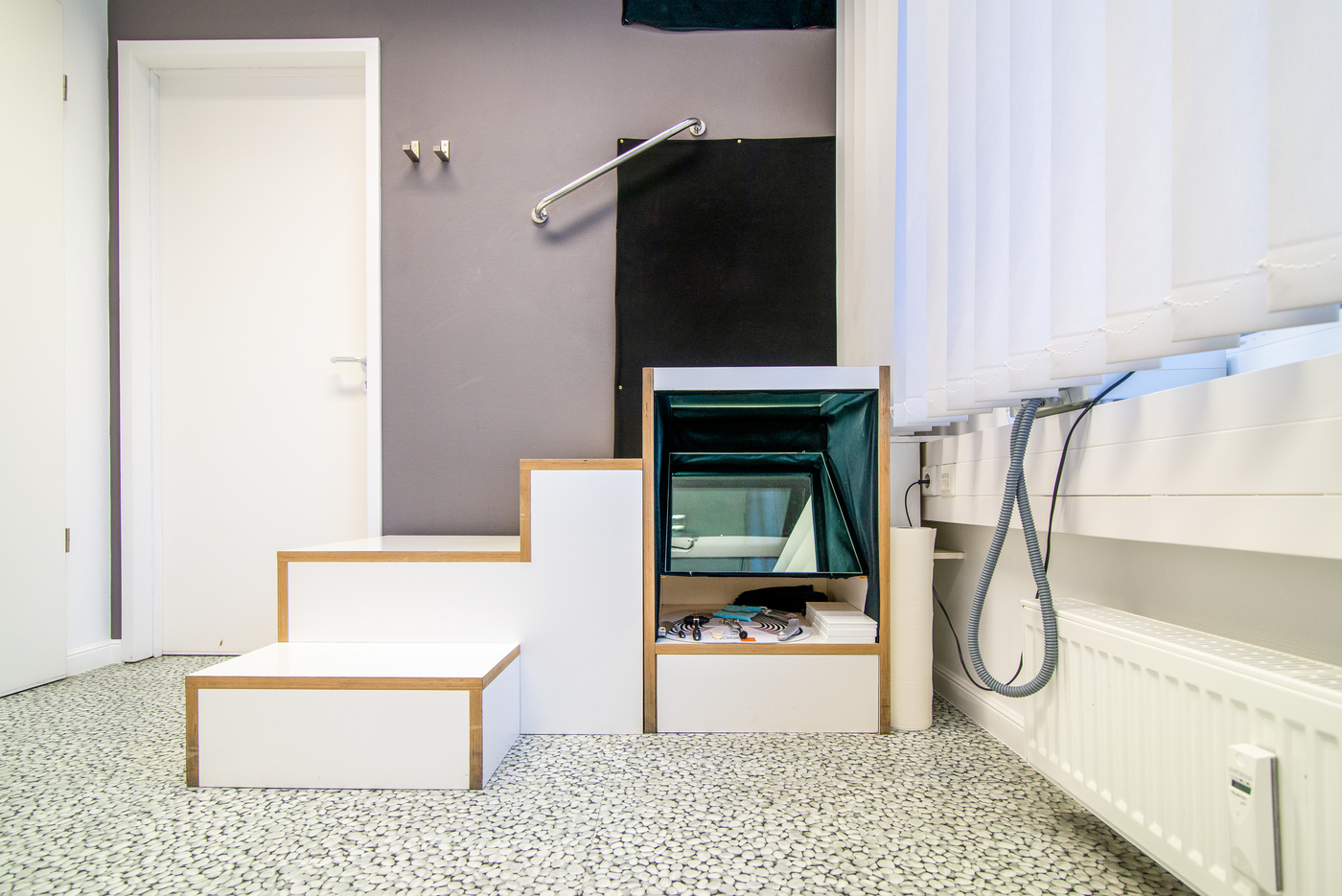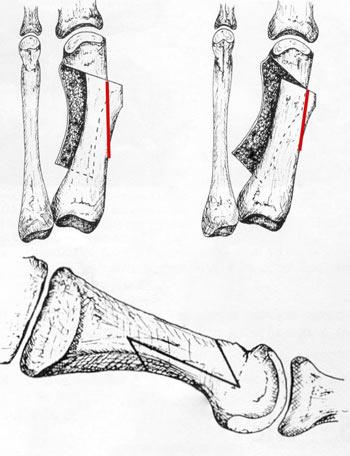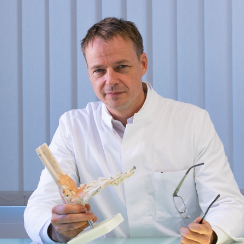A hallux valgus, also known as a bunion, literally comes from Latin (hallux = big toe, valgus = crooked) and means a crooked position of the big toe towards the outside, towards the small toes. In comparison, hallux varus means that the big toe deviates inwards towards the centre of the body. A hallux varus occurs very rarely, a hallux valgus, on the other hand, is a quite common deformity of the foot.
The cause of hallux valgus is instability in the tarsus, which is aggravated by continuous stress. Hallux valgus can also be congenital. In this widespread deformity, the first metatarsal stands with its head towards the inner edge of the foot and the big toe approaches the middle toes.
What is a moderate hallux valgus deformity?
During this foot disease, the joint axis deviates more and more from the static axis. The patient must therefore assume that the hallux valgus deformity will continue to progress and increase dynamically over time. It is therefore advisable to correct the axis at an early stage.
In a moderately severe stage, surgical correction of the crooked big toe with the Scarf osteotomy (operation according to Meyer Scarf) can be useful to avoid further damage to the toes and joints and to prevent arthrosis as secondary damage.
Here you can find specific information on Scarf osteotomy or surgery according to Meyer Scarf. You can navigate directly to the individual topics:
- What pain and symptoms indicate a moderate or advanced hallux valgus deformity?
- What exactly is done during a Scarf osteotomy (surgery according to Meyer Scarf)?
- When is the Scarf Osteotomy used?
- How does the foot surgeon examine and diagnose a moderately severe malformation of the bunion?
- What exactly is the procedure for a Scarf Osteotomy?
- Who pays the costs of hallux valgus surgery?
- What is the healing time after a hallux valgus operation according to Meyer Scarf?
- At a glance: All important information on the surgical correction of moderate hallux valgus deformities using scarf osteotomy.
- Which medical doctor should perform hallux valgus surgery with a scarf osteotomy?
Info:
In order to regress a hallux valgus in the first mild and moderate stages, the patient can also do something himself: e.g. strengthen the muscles of the feet regularly with targeted gymnastic exercises. About other Hallux valgus surgery procedures for mild or very severe hallux valgus deformity can also be found on our homepage.
For better understanding, we explain individual technical terms:
Osteotomy: Osteotomy is the surgical severing of one or more bones with the aim of subsequent position correction.
Scarf osteotomy or surgery according to Meyer Scarf: Surgical procedure with bone severing and a Z-shaped incision technique to correct malposition of the first metatarsal bone.
Metatarsal: Located in the foot between the tarsus and the toes.
Forefoot: The metatarsal bones and toes are called the forefoot.
Stable under load: In the bandage shoe, the patient can step fully immediately after the operation.
Sesamoid bones: The sesamoid bones are small roundish bones and are located below the 1st metatarsal head.
What pain and symptoms indicate a moderate or advanced hallux valgus deformity?
It is not possible to tell how far the hallux valgus deformity has progressed based on the pain that occurs. Pain always occurs individually and is not necessarily associated with a stage of the deformity. For example, a slight deformity can already cause severe pain, while a severe deformity can also be painless.
Tonio Gottlieb, MD, informs:
"With a hallux valgus problem, it can even happen that the pain is greater in the early stages than in the advanced stages. Therefore, one cannot conclude the degree of deformity from the intensity of pain that a patient describes."
What exactly is done during a Scarf osteotomy (surgery according to Meyer Scarf)?
In the Scarf osteotomy (surgery according to Meyer Scarf), the incision is z-shaped, i.e., the surgeon cuts through the bone in a z-shape. This is necessary because in an advanced hallux valgus deformity the metatarsal bones one and two move further and further apart and as a result the big toe can no longer be held in its original position. The Z-shaped incision of this hallux surgery method increases the area of the osteotomy and thus helps to stabilise the advanced deformity.
For patients with hallux valgus, the foot surgeon Tonio Gottlieb, MD, is the proven specialist in all aspects of foot orthopaedics and foot surgery. He examines them with the utmost care and always keeps the entire body statics in mind. Whether you need an initial diagnosis or a second opinion - make your personal consultation appointment now!

When is the scarf osteotomy used?
To determine the degree of hallux valgus, the foot surgeon will determine the intermetatarsal angle (IMW), which serves as an indicator for measuring various foot malpositions. The IMW is the angle between two metatarsal bones of the individual toe rays - so in the case of a hallux valgus deformity, the angle between the 1st and 2nd toe rays. The surgeon uses the intermetatarsal angle (IMW) to decide which surgical technique is suitable. Up to an IMW of 15 to 16 degrees, a scarf osteotomy is usually used to successfully operate on an advanced hallux valgus.
| IMW | Malposition | OP method |
| 8° – 9° | normal | - |
| 12° – 13° | slight deformity | Chevron osteotomy (surgery according to Austin) |
| 15° – 16° | medium malalignment | Scarf osteotomy (surgery according to Meyer-Scarf) |
| >16° | severe deformity | Basic wedge osteotomy (arthrodesis according to Lapidus) |
Can both feet be operated on at the same time?
In principle, hallux valgus surgery can be performed on both feet at the same time. However, this procedure is not recommended because the patient's mobility is completely restricted in this case. The foot surgeon therefore recommends operating on one foot after the other in the case of a hallux valgus diagnosis, so that the patient can always still put full weight on the healthy foot.
How does the foot surgeon examine and diagnose a moderately severe malformation of the bunion?
To diagnose hallux valgus, the first thing the foot surgeon does is start with:
- Anamnesis (patient interview), followed by a detailed physical examination. A special foot platform is also available for this purpose, which facilitates the clinical examination.
- The diagnosis is then confirmed by an X-ray under stress. This imaging procedure can also reliably assess the stage of the hallux valgus deformity based on the intermetatarsal angle (IMW).
The foot expert then gives concrete recommendations for a successful correction of the hallux valgus and suggests the most suitable procedure and surgical method. In the case of a moderate hallux valgus deformity, this can be an operation according to Meyer Scarf.
Good to know: A tailor's bunion operation (for malposition of the little toe) is also operated on with a z-shaped scarf osteotomy.
What exactly is the procedure for a Scarf Osteotomy?
 Scarf osteotomy involves a bony rearrangement of the first metatarsal bone. The surgeon cuts through the head of the metatarsal bone in a Z-shape, moves it outwards and then fixes it with two small titanium screws. These screws can remain in the foot after the operation. The aim of the scarf osteotomy is to bring the metatarsophalangeal joint and the sesamoid bones back into the correct position. This hallux valgus surgery can be performed on an outpatient or inpatient basis. The decision always depends on the individual diagnosis and living situation of the patient. For older patients who live alone, an inpatient stay of a maximum of three days is recommended after the hallux operation.
Scarf osteotomy involves a bony rearrangement of the first metatarsal bone. The surgeon cuts through the head of the metatarsal bone in a Z-shape, moves it outwards and then fixes it with two small titanium screws. These screws can remain in the foot after the operation. The aim of the scarf osteotomy is to bring the metatarsophalangeal joint and the sesamoid bones back into the correct position. This hallux valgus surgery can be performed on an outpatient or inpatient basis. The decision always depends on the individual diagnosis and living situation of the patient. For older patients who live alone, an inpatient stay of a maximum of three days is recommended after the hallux operation.
Who pays the costs of hallux valgus surgery - in our case for a scarf osteotomy for an advanced bunion of the big toe?
What about the costs for such a hallux valgus operation (scarf osteotomy)? In most cases, the inpatient surgery costs, which make up the largest part of the hallux valgus surgery, are covered by the health insurance companies (both statutory and private). Thus, for a hallux valgus surgery, only a minor cost compensation towards the surgeon as well as for the outpatient follow-up treatment must be paid privately.
What is the healing time after a hallux valgus operation according to Meyer Scarf?
 The healing time after a hallux valgus operation (scarf osteotomy) is about six weeks. During this time, the patient must wear a post-OP shoe. This shoe is so stable that the patient can walk fully after the hallux valgus surgery. No further walking aids are needed. The wound is expected to heal in about two weeks. After that, physiotherapy can be started. Bone healing takes about six weeks, after which the foot is stable again. The inability to work depends on the type of activity. In the case of a sedentary occupation, the patient can usually return to work immediately. For occupational activities with physical strain, a sick leave of at least six weeks must be expected.
The healing time after a hallux valgus operation (scarf osteotomy) is about six weeks. During this time, the patient must wear a post-OP shoe. This shoe is so stable that the patient can walk fully after the hallux valgus surgery. No further walking aids are needed. The wound is expected to heal in about two weeks. After that, physiotherapy can be started. Bone healing takes about six weeks, after which the foot is stable again. The inability to work depends on the type of activity. In the case of a sedentary occupation, the patient can usually return to work immediately. For occupational activities with physical strain, a sick leave of at least six weeks must be expected.
How long will I be in pain after the hallux operation?
Pain after hallux surgery can be kept under control very well. Especially during an inpatient stay (approx. 3 days), the pain can be reduced to a minimum by immobilising the operated foot and individually adapted painkiller indication. Immediately after the operation, the pain should reduce quickly. Six to eight weeks after a hallux valgus operation, the patient is usually pain-free again and after about half a year, complaints should have completely disappeared. In the very rare case that patients still have pain a year after hallux surgery, neurological or mechanical causes may be responsible.
Dr Tonio Gottlieb, MD:
"I often say to my patients: The foot starts between the head. This means that everyone's perception of pain is subjective and each patient processes hallux valgus surgery individually and at their own pace. However, when pain arises, it can be kept under control very well with pain therapy."
At a glance:
All important information on the surgical correction of moderately severe advanced hallux valgus deformities with the scarf osteotomy.
- Treatment type:
- Outpatient or inpatient (max. 3 days)
- Hallux valgus surgery duration:
- 60 to 70 minutes
- Hallux valgus OP
surgery aftercare: - 6 weeks Bandage shoe
No crutches - Stability:
-
Full weight bearing: the foot is immediately stable underweight bearing, i.e., the patient can step out fully in the post-OP shoe immediately after the operation.
Which doctor should perform hallux valgus surgery with a scarf osteotomy?
 Which is the best doctor for your hallux valgus surgery? In the case of a moderately severe hallux valgus deformity, it is always advisable to consult a specialist in the field of foot surgery. An untreated hallux valgus not only causes discomfort, it also often leads to arthrosis, as the joint wears out more quickly due to the deformity. Therefore, hallux valgus should always be diagnosed and operated on by a foot specialist. For all hallux valgus symptoms, the experienced foot surgeon Tonio Gottlieb, MD, is the ideal contact person. He recommends the best therapy for the treatment of hallux valgus depending on the individual case. He always works holistically and considers the entire statics of the foot and the body. He also has many years of experience in the Scarf Osteotomy presented here and can perform it successfully and without complications. So, you can assume very good chances of success for your hallux valgus operation.
Which is the best doctor for your hallux valgus surgery? In the case of a moderately severe hallux valgus deformity, it is always advisable to consult a specialist in the field of foot surgery. An untreated hallux valgus not only causes discomfort, it also often leads to arthrosis, as the joint wears out more quickly due to the deformity. Therefore, hallux valgus should always be diagnosed and operated on by a foot specialist. For all hallux valgus symptoms, the experienced foot surgeon Tonio Gottlieb, MD, is the ideal contact person. He recommends the best therapy for the treatment of hallux valgus depending on the individual case. He always works holistically and considers the entire statics of the foot and the body. He also has many years of experience in the Scarf Osteotomy presented here and can perform it successfully and without complications. So, you can assume very good chances of success for your hallux valgus operation.
The foot surgeon Tonio Gottlieb, MD, is your experienced expert in all aspects of foot surgery and foot orthopaedics. He examines you with the utmost care and always has the entire body statics in mind. Based on a cause-oriented diagnosis, he will give you an individual, stringent recommendation for action. Whether you need an initial diagnosis or a second opinion - make an appointment for a personal consultation!



